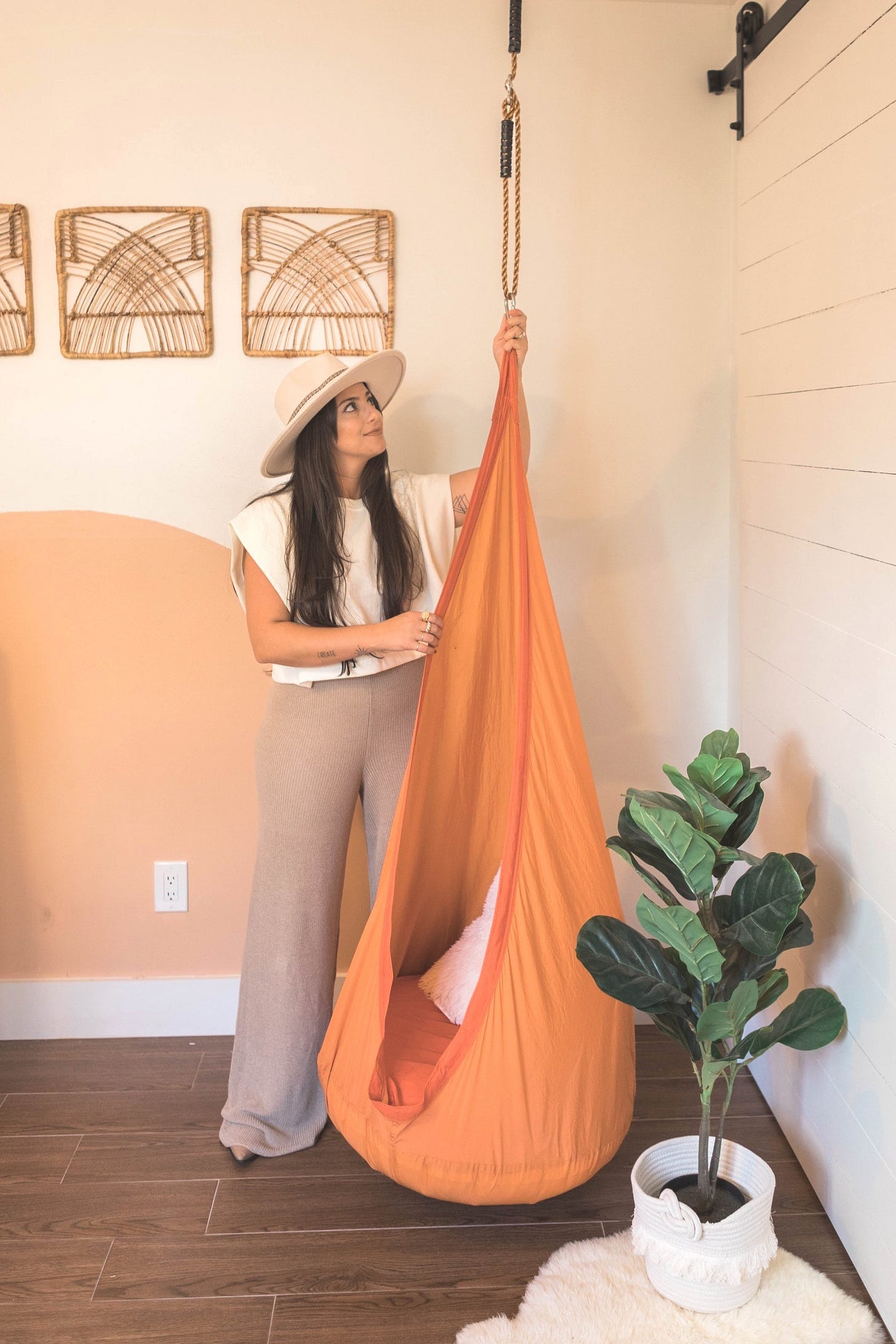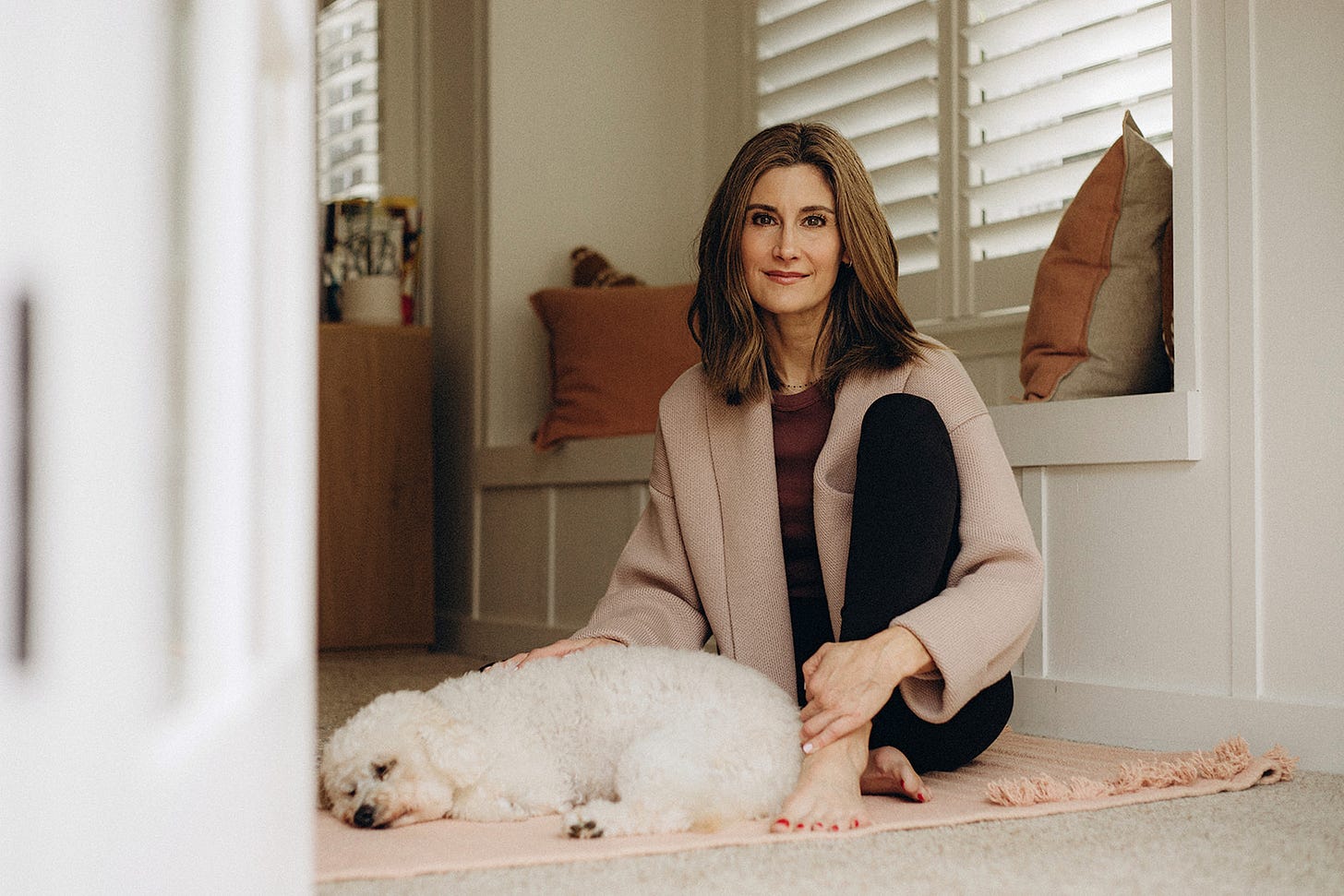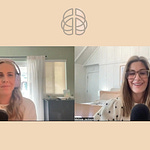My friend, Jacqui recently shared how a top down approach and talk therapy has not been enough for her. She is still disassociating from her feelings and body after years of being invalidated as a neurodivergent person (relatable right?)
So as she’s finishing up her Polyvagal Felt Sense certificate, I asked her to join our paid community to share how this methodology is helping her feel more and disassociate less (and to walk us through a live session so you can use this resource too.)
What to do if you’ve been disassociating from your body
Jacqui: This process, has helped me get back into my body and realize, Oh, wait, I don't even have the vocabulary to describe what's going on in my body.
It's been really helpful for me to even explore describing these sensations and to take a moment to really feel and get out of that dissociative state that is my familiar. It’s unfamiliar for me to really feel.
I feel like neurodivergents who have been diagnosed later in life, like myself, we've been so dissociated from feeling because others aren't feeling the same intensity or we're downplaying our sensations.
When, that music (for example) really is hurting my ears. So this practice has really allowed me to validate my sensations in a way where I can just sit with it and feel it and get re-tuned into my body again.
Melissa: It's almost like retraining our bodies that feeling is safe. We know the nervous system is wired to think anything that's unfamiliar, even if it is safe, is unsafe. So our coping mechanism of dissociation is felt as safe. But with this, we get to shift that programming.
Jacqui: That's a hundred percent on point. What is truly safe does not feel safe for us because it's unfamiliar.
Melissa: So is this Polyvagal Felt Sense experience we’re going to do, is a somatic therapy? Is that how you would categorize it?
Jacqui: Yeah, this would be more of a somatic approach to, what I'm calling, re-tuning or retraining our body to feel safe and to feel.
It's combining the felt sense and a focusing session.
The concept of a focusing session is by Eugene Gendlin of focusing.org, and this method is really about being a good listener and focusing inward.
And then, Jan Winhall has developed the Felt Sense Polyvagal Model, as an approach to trauma and addiction, really stepping away from the 12 step model.
When talk therapy alone isn’t enough…
I'm learning all of these modalities, because the top down approach has not been enough for me. Talk therapy has not been enough. Because I'm still dissociating.
This is helping me getting back into my body and to stop dissociating and to feel safe within my body again. Co-regulating and doing this practice with someone live has helped me feel safe while doing it too.
Melissa: And you don't have to be in the same room, for this to work, right? You can co-regulate through listening to us doing this exercise today.
Tat’s one of the reason’s I’m so excited to share this resource with my community.
I feel like I'm addicted to dissociating. So the idea that we can start to stop the cycle of addiction to leaving my body and come back to feeling instead feels great.
Jacqui: It's funny you said that because, I was stopped drinking while I was taking this course because, for me, grabbing a drink was more of an associated, unhealthy coping strategy. I just felt like during this certificate, I wanted to stop drinking so that I could work on that and find other coping strategies to feel- anything.
To feel what I'm feeling- the anxiety, the anger, whatever it is.
So instead, I just got in the shower and I felt the water. Like, even though I want to dissociate right now, I can handle these emotions.
Melissa: Yes. You know what I've been noticing? I have been dissociating with scrolling on Instagram or shopping, you know?
We all have these, it could be alcohol, it could be even exercise. The activity is neutral, it's when we're using it and the intention behind it, that's not serving us.
If we're using it to escape feeling the feelings in our body.
Jacqui: Exactly. Yeah, that's exactly what it is. So becoming aware and taking a moment to go inward and to feel and to be just to be with it.
Melissa: Which is so confronting, right? I feel like we're all running from that because we've laid those neural pathways but now we’re realizing we need to redirect them and it’s uncomfortable.
But it's like, what we're running from the most is actually what heals us the most. It’s what we need the most, right? The thing that feels the hardest is probably the medicine.
Regulating our systems all day
Jacqui: Exactly. And our perception of regulation being linear, is a misconception.
It comes with a lot of self shame, like: “Why can't I be regulated or calm all day?”
But regulation is not about being calm. Regulation is about being flexible to be with the swirls, right? Because it's not a line.
And that's uncomfortable for us, right? Because it feels like that's wrong, but it's not actually.
Melissa: I'm so glad you're bringing this up because I think we have this misperception of: if we're regulated all day, we're doing it “right.”
And if we're dysregulated, we're doing something wrong. And that triggers those negative thought loops of shame and I'm bad and why can't I get this together and all the things, which just makes us feel more dysregulated.
But when we can reframe it as, no, I'm not doing anything wrong. This is what the nervous system does. And pairing that with learning tools to be with it and bring ourselves back to a ventral state again- it helps us figure out how to be okay with being dysregulated. Knowing it’s a part of the human experience and that I'm not going backwards.
Jacqui: Right. Then being in a ADHDer we now know in learning about our brains, that we feel more intensely. So befriending our brain and not resenting our reactions or ourselves for big intensity of emotions, it’s ok- this comes with my brain, let's be friends. Let's figure this out.
Melissa: It's helping our nervous system when our response is softness, right?
The more we're judging and critical and why can't I be on time? Why didn't I allow extra time to figure out the tech or to get my cup of tea or make sure my dog's not barking.
I feel like for me, the habit has been so ingrained to go to the self judgment.
I literally have a picture of me in kindergarten as my screensaver right now to remind myself to be sweet to myself, to my inner child. Because when I do inner child work, I can find so much compassion for these little versions of me and how I got to where I am now. But sometimes I forget that’s me, right?
And so I'm trying to have her as a reminder of, how did I talk to her? Like, it's okay that you're late. It's normal that your body is having this reaction. It's your nervous system trying to keep you safe. Just trying to retrain that inner narrative I have going.
Chronic PTSD from our Neurowiring + Environments
Jacqui: It's crucial because our inner dialogue, it's still the same as when we were kids. And being a visual person, it's so powerful to see our little selves.
Melissa: It's like laying these new neural pathways to automatically go down a different thought path. This path has been walked so many times- to go down the shame path. The softness path is brand new path, so it’s like I’m walking through the forest trying to clear it and create it. So any reminders to: be softer, be softer, be softer.
Jacqui: I think we're similar in that we're learning to better understand ourselves to them better help other neurodivergents and families through our lived experiences.
And, you know, this topic of trauma and neurodivergence I feel there's not that much information about it. We have felt trauma and I think all the little t's end up being chronic PTSD.
The results of not trusting our bodies is real. And so this practice is helping me trust myself to feel safe in my body, in my sensations, and validate that what we have experienced in our lifetime, is safe.
And because of neuroplasticity we are able to rewire and retune and change that narrative- because that narrative has power.
So to make that loop a positive narrative versus the talk therapy, I still go, but sometimes it was just rewiring the negative story. I know that I needed more after seven years. Other modalities, like somatic work. It’s a “yes, and.”
Top down is important because of neuroplasticity, but also bottom up needs to happen in order to fully heal the mind-body connection. You know what I mean? That's what I'm calling yin and yang.
Melissa: Yeah. And I think also having a therapist who understands complex trauma.
So you're feeling validated and safe in your experiences from the top down and having these bottom up types of support.
Jacqui: The more we speak up about our lived experiences, the more we can heal collectively.
A live Felt Sense Experience Meditation
And that's why I love that you brought me on here today.
Melissa: If you're ADHDer, you need at least one ADHD friend to make you feel normal.
Jacqui: That's it!
So, are you in the space to clear your space and go inward now? Do you want to do that right now?
So, picture this like a live meditation. It's really about co-regulating and there's six steps (you're not going to feel it as six steps but there are for me.)
First, we're going to clear space.
And then we're going to that felt sense.
Then there's something called a handle, which we're going to think of a word or a phrase to describe the felt sense. Sometimes I don't have a word and I do like a gesture.
And then you're going back and forth, really getting into the body.
Asking
And then receiving.
Those are the six steps, but again, it's not gonna feel that way. I like to know what I'm getting myself into before.
Melissa: It's very dyslexic friendly. We like to know the big picture and then now I can think into what we're doing.
Jacqui: Exactly. Because then I will be like, so anxious of like, but what's next? What's next? Cool. So, bear with me, as I am too learning. But we're going to do this right now.
Meditation Only Recording (so you can listen as often as you’d like)
Jacqui: I want to read something that Jan Winhall says:
“If during these instructions somewhere you have spent a little while sensing and touching an unclear, holistic body sense of this problem, then you have focused. It doesn't matter whether the body shifts came or not. It comes on its own. You don't control that but you did focus right now. And this was not even 15 minutes.”
I didn't want to interrupt your feeling, but were you able to sense a difference in the shift?
Melissa: Immediately, for me, I was aware of this energy I could feel in my head.
It felt, like: busy, chaotic, almost like the stickiness was tangled up in ropes or strings. Like, you're trying to pull at all the strings and you're just getting more wrapped up.
So I was able to move it down into my throat and into my chest. And I could feel like, when you pull on just the right string and then everything falls. It was very visual for me. I pulled the string and it was this immediate sense of calm. All the worries fell to the ground and I felt free.
Jacqui: I love that analogy. That's so powerful. And it's a quick shift.
So much healing has happened since receiving my diagnosis over these last few years and then befriending my brain to befriend my nervous system. And compassion has also helped me heal too.
Receiving a late-in-life Neurodivergent Diagnosis
Melissa: Do you feel like receiving that diagnosis was helpful for you?
Jacqui: Yeah, it just helped it all make sense. I wish I would have learned about it when I was younger. I think that's why I feel so passionate about advocating for these students at the middle school I'm working at now. A lot of them don't know so I'm already seeing that negative loop in them as teenagers. And it just breaks my heart because school was so hard for me.
Melissa: Yeah. School was hard for me too. I didn't know I was dyslexic going through school, but I knew starting in high school, I had ADHD.
The only real support I received then was medication. It was like, here's your solution. Which helped me focus, and my grades improved which built my confidence so I saw how capable I was when I listened.
I then started separating my intelligence a bit from my attentiveness but the damage was done from the messages in my formative years. Like not feeling good enough or not feeling smart enough.
But I wasn't really given any other support or understanding.
Educating ourselves about ADHD
Until I've been self-educating as an adult about:
What is ADHD?
Why do our brains function in this way?
What are some actual behavioral strategies and supports to put in place to make life easier?
I feel like I'm still navigating all of this, learning it later in life, even though I’ve had the label for so long.
I feel like that comes from our professionals not having a comprehensive understanding of it. So then our parents didn't have a comprehensive understanding of it.
Jacqui: Yeah, it's a lot of things. Self-educating has been so helpful for me too.
Navigating Our Neurodivergence with our Kids
We have a similar story where I was learning about the neurodiversity affirming movement for my clients and then learning through my children's experiences. And that's when I was like, Oh, wait, I'm actually neurodivergent myself.
Melissa: I think this is a story for so many of us, because I learned more layers to my neurodivergence through my children's neurodivergence. I know with moms that I work with here in this group, the shift really comes in our lenses and our perspective and how we radically accept ourselves and radically accept our kids.
Jacqui: Yeah. It's almost like once we can radically accept ourselves, we can open up our heart to radically accept our children.
In Amanda’s Low Demand Parenting Handbook, she talks about radical acceptance and how our lenses need to change first in order to meet our children where they are. Because we will never meet them where they are if our lenses are not accepting.
We become parents having this image of what our child will be and we really have to let that go. And with that comes grief. And that's another emotion that we push down.
Every time I drop a demand for my children to promote connection and regulation, and to meet them where they are, there's grief.
Every time we don't sit at the dinner table, there's grief.
Every time I have to carry him to go brush his teeth, there’s grief.
You know what I mean? And, it's okay, because at the end of the day, we have this authentic connection and peace in our home. And that's what matters.
It's like, oh, but we have to sit at the table. Well, who says who? Right? This is what it's about.
And it's not really talked about, right? We have these societal expectations and conditioning and we're rewriting our story where we're recreating a whole new world for neurodivergence. We’re breaking cycles on so many levels.
Connection with our kids above all else
Melissa: And as a mom, having to stand in that knowing that: a lot of people are not going to get low demand parenting and you're actually going to receive judgment from a lot of people that you're not “doing it right” or you're not “doing a good job.”
And it's like that radical acceptance of my connection and safety with my child is paramount and everything else falls into place after that.
Jacqui: Yeah. This has been life changing for me, learning about this because I'm a Speech Language Pathologist, Social Emotional Coach, I've done certificates in sensory processing and I've tried all the things. I self educate to better understand and connect with my children and nothing was really working.
But what I did not know was nervous system burnout and PDA, Pathological Demand Avoidance, a proposed disorder and a rare behavioral phenotype of Autism Spectrum Disorder.
At the time my son was 5, and we all have demand avoidance at some point or another, but giving them the autonomy, giving them the benefit of the doubt, like, okay, you had a rough day today. I'm going to carry you, cause you know, their feet don't work a lot. And I didn't realize that this was a characteristic of PDA. I really had no idea. So understanding, actually at the end of the day, my feet don't really work either. And giving them autonomy and understanding their perception of threat. I also didn't realize my questions, my communication style was being perceived as a threat in their nervous system by asking a WH- question.
So really understanding that our role in their nervous system reflex, if they respond with rage or explode, has nothing to do with me, I don't have to take it personal, and that they're not intentionally being defiant or oppositional. Then I was able to stay connected and have that space to co-regulate and let them borrow my regulation versus me also going into a dysregulated state because I was taking it personal.
But now doing these practices has helped me hold space for them while also holding space for myself and being able to, what I call, create that sensational connection, through the emotions and through the dysregulation.
Because I am their safe person.
Amanda says: “When you lower demands, you're trusting connection.”
And I loved that because that's exactly what we're doing to meet them where they are. And over time, that repair, that reconnection, holds so much more value than any practical tip you could apply.
It's just a beautiful thing once we get there. Helping them get out of burnout, helping them understand their felt sensations has really helped me heal.
Why doing this work is so important for mothers
Melissa: Yeah and it just speaks to why it's so important for us as mothers, as the adults to learn these strategies for ourselves, to be able to feel our feelings and be in our bodies and identify when we're starting to feel dysregulated- without blame or shame or for ourselves or our child, right?
So tools that create the distance between the stimulus and the reaction, between how we're feeling triggered, that starts with us. Because if we don’t have that sense of safety and connection then we don’t have the foundation for all the things to fall into place,.
I heard somebody say that: 90% of communication is unspoken.
It's like, if we're dysregulated, if we're feeling all these things, even if we're saying the right thing in the right phrasing, if our energy is disconnected, dysregulated, and unsafe, Is that going to help? Is that going to land?
Jacqui: It’s about what we’re embodying, right? We're so attuned to one another being highly sensitive and neurodivergent, and all of those nonverbal implicit communications (facial expression, body language, intonation, all of these things) are detected- as a safety or threat.
Deb Dana says: “Our nervous system is going to go into a state of protection or safety and connection. It's two pathways and we have a choice. We have the power to either promote protection or connection.”
I just loved how she explained that.
Melissa: Yeah, it makes so much sense. And reminds me when we look at it as this full circle experience, as us as these cycle breakers holding the space for these kids. When we, as the mom, change it almost automatically changes the child.
That's the quick way. If their primary caregivers in the home have that radical acceptance, are self regulated or know how to find that safety and can create that space between the child's behavior and their response to co regulate. And then they're framing the neurodivergence through a positive strength based lens, even if that child goes to school and hears the messages that they're going to hear in the culture and society that we live in, that foundation is so much stronger. That core of who they are and the safety they feel in their body and relationship with their primary caregivers, I think that stuff can bounce off a little bit more.
Jacqui: Yeah. That generational trauma has been passed on from generation to generation and it’s like- when are we going to pass on the healing?
I do believe we're the first generation to break those cycles. That's our hope, right?
Melissa: For sure. And it's not easy because we weren't given the tools and we're trying to create something new, but no one's modeled this for us or shown us how to do it. And we've got all this trauma in our bodies that our only tool for coping is to disassociate. So we're trying to rewire our nervous system. And then the added pressure of oh, and by the way, you've just got children- don't mess them up or pass this on to them, no pressure.
It's like the felt sense experience you just guided me through, I feel like my brain is filled with so many strings and they're all tangled. But what if you just pulled at the right one and everything fell into place?
What if mom's just invested in themselves? And it all got to be easier.
Jacqui: Yeah. I saw this visual today, and, you know, how for New Year's when you get champagne glasses and you make a pyramid and you just pour one and then it pours into others.
They said, you have to pour your own cup first to then pour to your family and your children. And if all the cups are aligned but you're pouring the others, then ours stays empty. It's such a nice visual.
Melissa: Yeah. And I think it's really a shift in perspective because what our mothers and grandmothers were taught and then modeled for us was like, that's selfish. You put yourself last if you're a good mom. You take care of everyone else's needs and you come last.
But then what happened? All of these women were resentful and exhausted and disconnected. And then the impact that had on the next generation.
I've noticed that when I started making this shift in my life, I would feel guilty for prioritizing myself. I noticed this narrative in my mind, like that means I'm selfish or not a good mom if I have needs that matter and I take care of them.
Jacqui: And it's unfamiliar and it doesn't feel safe.
Melissa: Yeah. Right. It's not familiar. You have to lean into it. There's a saying that our bodies will choose a familiar hell over an unfamiliar heaven every time.
Jacqui: And it's true. I'm constantly throughout my day, telling myself": I am safe.
Literally repeating: I am safe, even though I'm late. I am safe, even XYZ just happened. And it has helped bring down my anxiety in the moment.
Just retraining that story in our head. Rewriting it.
Thank you for co regulating with me.
Melissa: I know. Don't you feel calmer? I feel calmer.
Jacqui: I do. Can we talk all day? The beauty of co regulating with others.
Melissa: You feel safe.


























